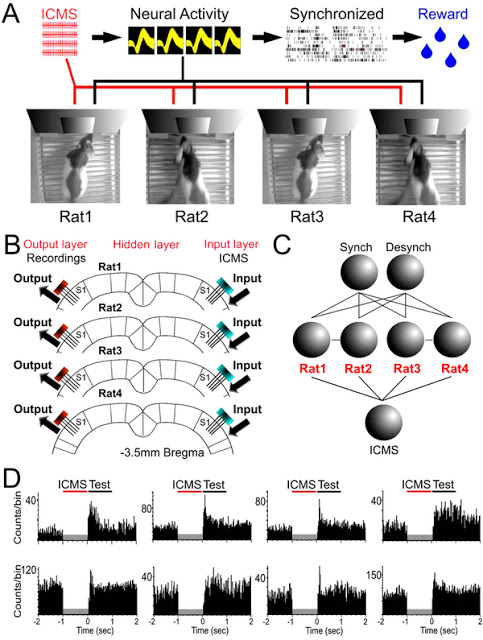Researchers have linked multiple rat brains and multiple monkey brains and synchronized them and trained them to perform classificiation and other tasks
Nature Scientific Reports – Building an organic computing device with multiple interconnected brains
Researchers proposed that Brainets, i.e. networks formed by multiple animal brains, cooperating and exchanging information in real time through direct brain-to-brain interfaces, could provide the core of a new type of computing device: an organic computer. They describe the first experimental demonstration of such a Brainet, built by interconnecting four adult rat brains. Brainets worked by concurrently recording the extracellular electrical activity generated by populations of cortical neurons distributed across multiple rats chronically implanted with multi-electrode arrays. Cortical neuronal activity was recorded and analyzed in real time, and then delivered to the somatosensory cortices of other animals that participated in the Brainet using intracortical microstimulation (ICMS). Using this approach, different Brainet architectures solved a number of useful computational problems, such as discrete classification, image processing, storage and retrieval of tactile information, and even weather forecasting. Brainets consistently performed at the same or higher levels than single rats in these tasks. Based on these findings, they propose that Brainets could be used to investigate animal social behaviors as well as a test bed for exploring the properties and potential applications of organic computers.
A 4-rat Brainet was capable of maintaining a level of global neuronal synchrony across multiple brains that was virtually identical to that observed in the cortex of a single rat.
In conclusion, they propose that animal Brainets have significant potential both as a new experimental tool to further investigate system neurophysiological mechanisms of social interactions and group behavior, as well as provide a test bed for building organic computing devices that can take advantage of a hybrid digital-analogue architecture.
A) A Brainet of four interconnected brains is shown. The arrows represent the flow of information through the Brainet. Inputs were delivered as simultaneous ICMS patterns to the S1 cortex of each rat. Neural activity was then recorded and analyzed in real time. Rats were required to synchronize their neural activity with the remaining of the Brainet to receive water B) Inputs to the Brainet were delivered as ICMS patterns to the left S1, while outputs were calculated using the neural responses recorded from the right S1. C) Brainet architectures were set to mimic hidden layers of an artificial neural network. D) Examples of perievent histograms of neurons after the delivery of ICMS.
The Brainet can synchronize neural activity
A) The different colors indicate the different manipulations used to study synchronization across the network. During the pre-session, rats were tested for periods of spurious neural synchronization. No ICMS or rewards were delivered here. During sessions, rats were tested for increased neural synchronization due to detection of the ICMS stimulus (red period). Successful synchronization was rewarded with water. During the post session, rats were tested for periods of neural synchronization due to the effects of reward (e.g. continuous whisking/licking). Successful synchronization was rewarded with water, but no ICMS stimulus was delivered. B) Example of neuronal activity across the Brainet. After the ICMS there was a general tendency for neural activity to increase. Periods of maximum firing rate are represented in red. C) The performance of the Brainet during sessions was above the pre-sessions and post-sessions. Also, delivery of ICMS alone or during anesthetized states also resulted in poor performances. ** and *** indicate P < 0.01 and P < 0.0001 respectively. D) Overall changes in R values in early and late sessions show that improvements in performances were accompanied by specific changes in the periods of synchronized activity. E) Example of a synchronization trial. The lower panels show, in red, the neural activity of each rat and, in blue, the average of neural activity for the remaining of the Brainet. The upper panels depict the R value for the correlation coefficient between each rat and the remaining of the Brainet. There was an overall tendency for the Brainet to correlate in the beginning of the test period.
Monkey Brains linked as well
Nature Scientific Reports – Computing Arm Movements with a Monkey Brainet
Traditionally, brain-machine interfaces (BMIs) extract motor commands from a single brain to control the movements of artificial devices. Researchers introduce a Brainet that utilizes very-large-scale brain activity (VLSBA) from two (B2) or three (B3) nonhuman primates to engage in a common motor behaviour. A B2 generated 2D movements of an avatar arm where each monkey contributed equally to X and Y coordinates; or one monkey fully controlled the X-coordinate and the other controlled the Y-coordinate. A B3 produced arm movements in 3D space, while each monkey generated movements in 2D subspaces (X-Y, Y-Z, or X-Z). With long-term training we observed increased coordination of behavior, increased correlations in neuronal activity between different brains, and modifications to neuronal representation of the motor plan. Overall, performance of the Brainet improved owing to collective monkey behaviour. These results suggest that primate brains can be integrated into a Brainet, which self-adapts to achieve a common motor goal.

Brian Wang is a Futurist Thought Leader and a popular Science blogger with 1 million readers per month. His blog Nextbigfuture.com is ranked #1 Science News Blog. It covers many disruptive technology and trends including Space, Robotics, Artificial Intelligence, Medicine, Anti-aging Biotechnology, and Nanotechnology.
Known for identifying cutting edge technologies, he is currently a Co-Founder of a startup and fundraiser for high potential early-stage companies. He is the Head of Research for Allocations for deep technology investments and an Angel Investor at Space Angels.
A frequent speaker at corporations, he has been a TEDx speaker, a Singularity University speaker and guest at numerous interviews for radio and podcasts. He is open to public speaking and advising engagements.




